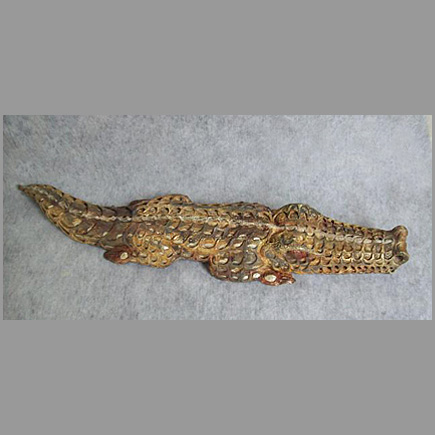Francisco Toledo (born 1940) Juchitán, Oaxaca, Mexico. Resides in Oaxaca, Mexico.
He studied at the Escuela de Bellas Artes de Oaxaca and the Centro Superior de Artes Aplicadas del Instituto de Bellas Artes, Mexico. In 1960 he moved to Paris from where he travelled through Europe. In 1965 when he returned to Mexico he started to promote and protect the arts and crafts in Oaxaca.
Toledo's art is imbued with his Mexican heritage of history and mythology. He has exhibited in many galleries in Mexico, Europe, South and North America and Asia. He is represented in public and private collections worldwide. According to one commentator (Christian Viveros-Faune): "Toledo's work is a seamless meshing of global and local culture and high art. Dream images from his childhood are fused with pre-Colombian symbolism and myriad references to the work of Dubuffet, Miro, Tapies, Klee, Tamayo, Blake, Goya, Ensor and Dürer, among other artists, and also to the writing of figures like Kafka and Borges. Snakes and turtles abound, as do rabbits and coyotes, bats and toads, crickets and dogs, as well as human figures from Mexican history, cycling from one work to another in a dizzying bestiary that is part ancient codex, part intensely modern graffiti. Toledo's work is based in part on the largely misunderstood shamanistic notion of the nagual, the belief that each human's fate is intertwined with that of an Aztec spirit in animal form."
For more than twenty years Toledo has been concerned with the well-being of the Oaxacan community and has devoted much of his wealth to this purpose. He is an untiring promoter, sponsor and disseminator of the cultural values of his native state, turning its main town into a dynamic centre for the visual arts and literature. He has created children's libraries in Indian communities, and has founded a number of important artistic and cultural institutions: the Museo de Arte Contemporaneo de Oaxaca, the Graphic Arts Institute of Oaxaca (which holds some 100,000 books on art and architecture), the Jorge Luis Borges Library for the Blind (which Toledo created after watching a group of blind people visit a nearby art museum), the Centro Fotografico Manuel Alvarez Bravo, Ediciones Toledo (a printing house, which most recently published translations of the poets John Ashbery and Seamus Heaney), and the Centro Cultural Santo Domingo (botanical garden, art restoration centre and library).
In 1993 Toledo was instrumental in founding Pro-OAX (the Endorsement for the Defense and Conservation of the Cultural and National Heritage of Oaxaca) dedicated to the protection and promotion of art, culture and the built and natural environment of Oaxaca. Through Pro-OAX Toledo has led efforts to protect the architectural and cultural heritage of Oaxaca's city centre. By turning his own private aesthetic activism into a groundswell of popular civic awareness, he has prevented the construction of luxury hotels, four-lane road expansions and asphalt parking lots. He is also credited with stopping the construction of a cable car to the sacred Monte Alban, and preventing the establishment of a McDonald's outlet in the town's main square. Far from preventing Oaxaca's development, through this activism the town has been transformed into one of Mexico's major cultural, artistic and political hubs.
In 2005 he received a Right Livelihood Award for devoting himself and his art to the protection and enhancement of the heritage, environment and community life of his native Oaxaca.
Spanish text:
Nació en Juchitán, Oaxaca, México. Reside en Oaxaca, México.
En la década de 1950, inicia sus estudios artísticos en la gráfica, en el taller de grabado de Arturo García Bustos. Posteriormente ingresa al Taller Libre de Grabado de la Escuela de Diseño y Artesanías, del Instituto Nacional de Bellas Artes (INBA), en la Ciudad de México. En 1959 exhibe sus obras en la Galería Antonio Souza y en el Fort Worth Center, en Texas.
Considerado uno de los mejores artistas vivientes de México, Francisco Toledo es inigualable. Es un experto impresor, dibujante, pintor, escultor y ceramista. Su arte y plástica refleja una gran apreciación por la estética de la naturaleza, particularmente la de animales que no son convencionalmente asociados con la belleza (murciélagos, iguanas, sapos, insectos). La visión moral de Toledo afirma que el mundo de los humanos y el de los animales son uno con la naturaleza. Toledo muestra un sentido de lo fantástico muy bien desarrollado al crear criaturas híbridas, parte humanas y parte animal, a la vez monstruosas y juguetonas, sus hermosos papalotes, libretas artesanales, máscaras, joyería e intrínsecos grabados son otra muestra de su genialidad.
El artista zapoteco se ha dedicado a promover y difundir la cultura y las artes de su estado natal, Oaxaca, donde actualmente reside. Con apoyo de otras instituciones funda en octubre de 1997 el Taller Arte Papel Oaxaca, instalado en la antigua planta hidroeléctica "La Soledad". Dentro de este contexto, fundó Ediciones Toledo, que en 1983 publicó su primer libro, y en 1988 creó el Instituto de Artes Gráficas de Oaxaca (IAGO). Fue ganador del Premio Nacional de Bellas Artes en 1998. A iniciativa suya se abre el 20 de marzo del 2006 CASA (Centro de Artes de San Agustín) en Etla, Oaxaca en donde se estudia fotografía, gráfica digital, diseño textil, educación a distancia, la preservación del patrimonio y el arte, enfocados también al medio ambiente. En 2005 recibe El Premio al Sustento Bien Ganado por dedicarse a la protección y mejora de la herencia, ambiente y vida de la comunidad de su natal Oaxaca. Hay obras suyas en los Museos de Arte Moderno de México, París, Nueva York y Filadelfia, en la New York Public Library, la Tate Gallery de Londres y la Kunstnaneshus de Oslo, entre otros. Ha ilustrado varios libros, y ha participado en numerosas exposiciones colectivas e individuales en ciudades como Nueva York, Londres, París, Ginebra, Oslo, entre otras. |
 Lagarto, 2008
Lagarto, 2008  Lagarto, 2008
Lagarto, 2008